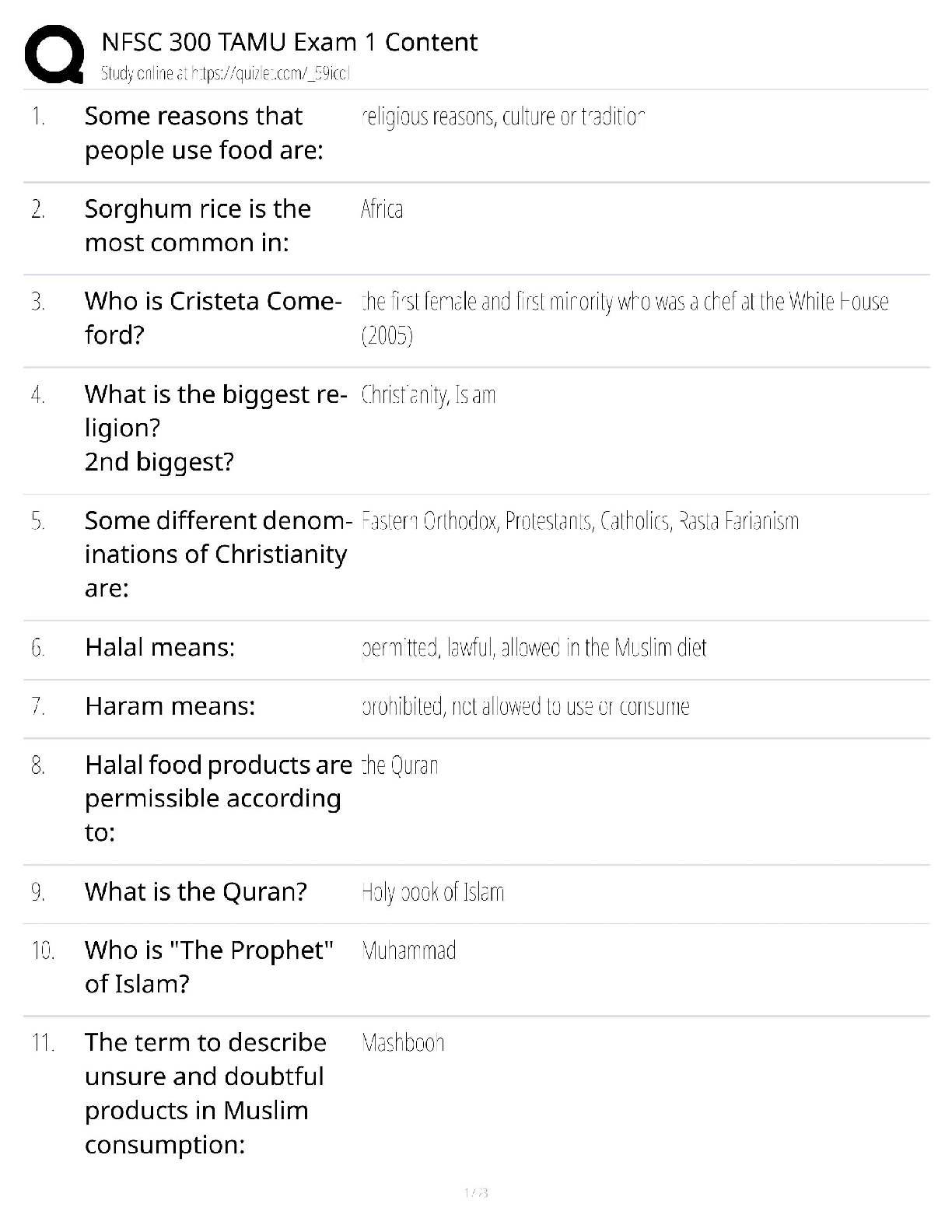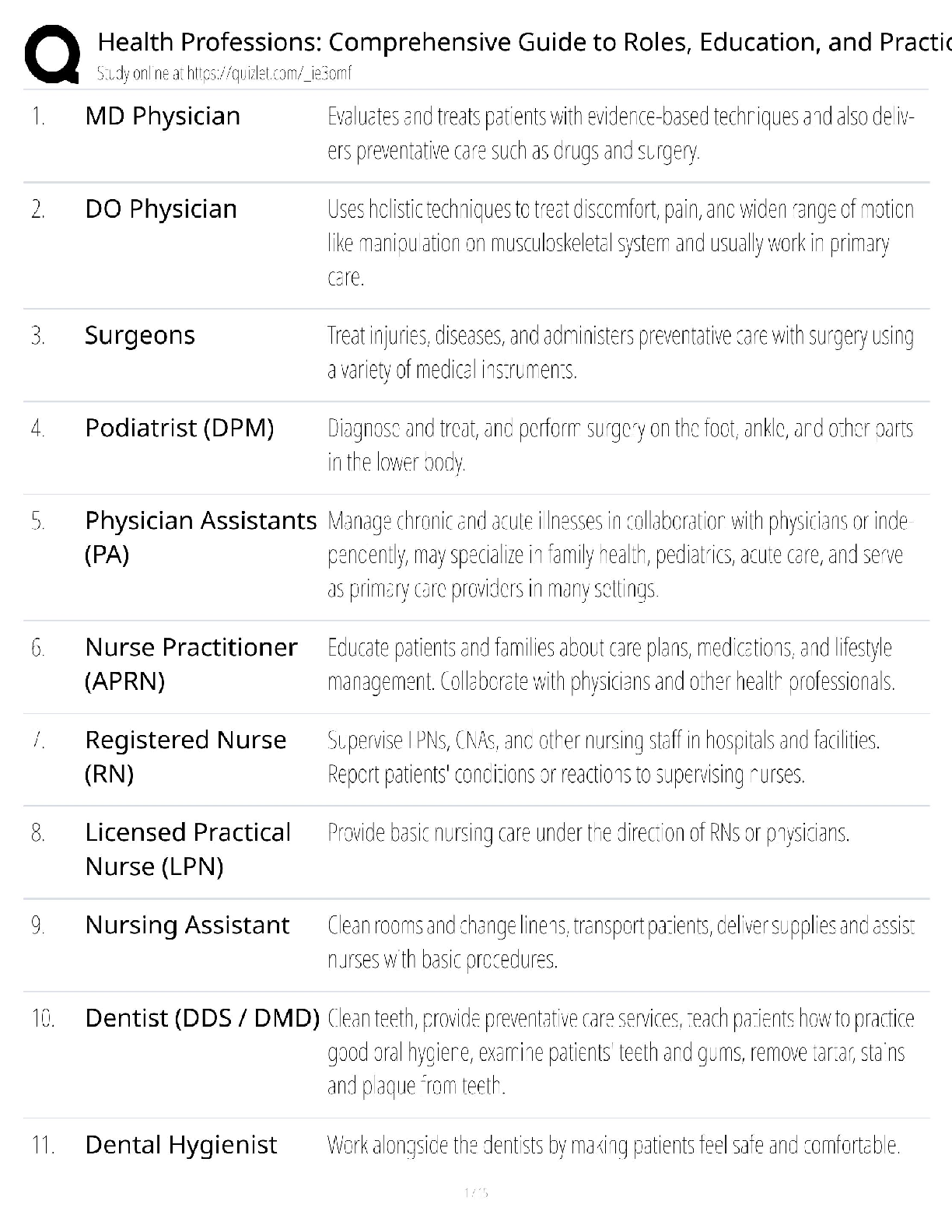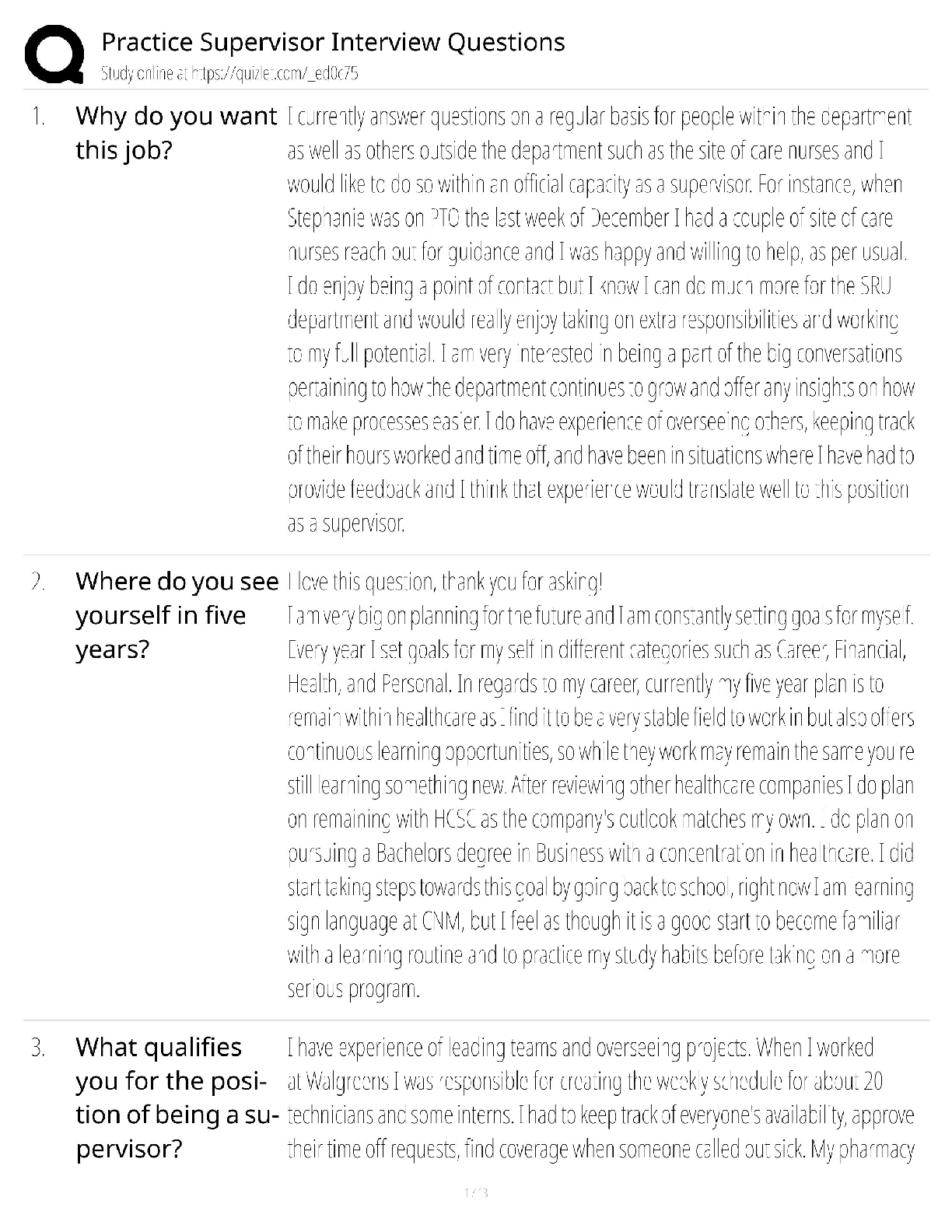UNIVERSITY OF TORONTO SCARBOROUGH CENTRE FOR FRENCH AND LINGUISTICS: WINTER 2020 FINAL EXAMLINA02H3S: APPLICATIONS OF LINGUISTICS. (Questions and Answers). Graded A
Document Content and Description Below
UNIVERSITY OF TORONTO SCARBOROUGH
CENTRE FOR FRENCH AND LINGUISTICS
INSTRUCTOR: SAFIEH MOGHADDAM
FIRST NAME(S): ____________________________________________________________________
TUTORIAL SECTIO
...
N: _______________________________________________________________
SECTION A B C D E F G TOTAL
STUDENT
GRADE
OUT OF 15 16 20 14 8 15 11 99
LAST NAME(S): ________________________________________________________________________
STUDENT NUMBER (S): _________________________________________________________________
LINA02H3S: APPLICATIONS OF LINGUISTICS
DUE DATE AND TIME: APRIL 18 (4 PM)
WINTER 2020 FINAL EXAMA. Fill-in-the-Blanks (15 pts)
1) Most speakers of a language speak in different ways depending on the context and the
person they are talking to. This is an example of ___________________.
2) _______________ is a mental grammar that is shaped by a speaker’s L1 and L2.
3) A variety of language spoken by a group of people who share the same ethnicity is called
a(n) ____________________.
4) The most severe type of non-fluent aphasia is ____________________ aphasia.
5) Hemispherectomies and split-brain studies suggest that most language processing happens in
the ____________________ hemisphere.
6) Suppose that you have a hemispherectomy patient who is a right-handed adult. If the patient
was blindfolded, they would be able to name an object if it was placed in their ______ hand.
7) A speaker’s _________________ is their actual use of language.
8) Accents are the result of phonetic/phonological ____________________ from a speaker’s L1.
9) According to the ____________________ Hypothesis, it is easier for an L2 learner to learn a
feature that is very different from their L1.
10) A child uses the word “kitty” to refer to the family pet but not to other cats. This is an example
of ____________________.
11) The innateness hypothesis for language acquisition claims that humans are biologically
endowed with an ability to learn language and the principles and properties that pertain to all
languages. This innate ability is called ____________________.
12) The most commonly occurring consonant is / _____ /.
13) ____________________ vowels are usually rounded.
14) The three most commonly occurring vowels are / _____ , _____ , _____ /.
15) The two most common word orders are _______________ and _______________.
Page 2 of 11B. TRUE/FALSE (16 points)
_____ Isolating languages avoid suffixes, using free morphemes to express notions such as
tense and number.
_____ Words in polysynthetic languages often need to be translated as entire sentences in
English.
_____ Derivational affixes attach closer to the root in comparison to inflectional affixes.
_____ The most frequent consonants at the babbling stage are [f, v, l, r]
_____ Consonants are acquired before vowels.
_____ Overextension is a type of lexical error.
_____ Dari and Tajiki are considered to be different languages since they are not mutually
intelligible.
_____ Most of the differences we notice in the language of men and women are biologically
determined.
_____ According to Lakoff, the language about men reflects their subordinate status in
society.
_____ The word ‘steady’ is an aspect marker in AAVE; it indicates an action that is occurring
consistently and intensely.
_____ In AAVE, the auxiliary ‘aint’ is only used in double negation constructions.
_____ In AAVE, the word ‘police’ is pronounced with the stress on the second syllable.
_____ China Town in Toronto is an example of an ethnolect.
_____ The one-word stage in child language acquisition is also referred to as the telegraphic
stage.
_____ Babbling is a stage at which children practice controlling their vocal apparatus.
_____ Interdental consonants are acquired before velar consonants.
Page 3 of 11C. SOCIOLINGUISTICS [20 points]
1) Which of the following is a possible pronunciation of the word “brother” in AAVE? Circle
all that apply. [1 point]
a) [brʌvə]
b) [bəvə]
c) [brʌdə]
d) [brʌðər]
2) Which of the following is a possible pronunciation of the word “cold” in AAVE? Circle all
that apply. [1 point]
a) [kol]
b) [ko]
c) [kolt]
d) [kowd]
3) In Canadian English, we use the term “elevator” to refer to a platform for raising and lowering
people or things; however, in British English, they use the term “lift”. This is an example of:
[1 point]
a) conversational practices c) accent
b) slang d) lexical variation
4) Which of the following varieties are considered dialects of the same language although they are not
mutually intelligible? [1 point]
a) Urdu and Hindi c) Cantonese and Mandarin
b) Farsi and Dari d) Both (a) and (b)
5) Match the each of the AAVE sentences on the left to its Standard English counterpart on the
right. Note that one of the English sentences does not have an AAVE counterpart. [4 points]
_____ I be washing the dishes.
_____ I BIN washing the dishes.
_____ I BIN washed the dishes.
_____ I done washed the dishes.
A. I washed the dishes a long time ago.
B. I have already washed the dishes.
C. I’ve been washing the dishes for a long time.
D. I am always washing the dishes.
E. I am washing the dishes now.
Page 4 of 116) What are the different ways by which dialects differ from each other? List them and provide an
example for each. [4 points]
7) In her article, Lakoff lists ‘color terms’ and ‘euphemism’ as two of the features of women’s
language. Discuss these two features and make sure to provide a specific example for each
feature. [3 points]
_
8) What makes Norwegian and Danish different languages? [2 points]
______________________________________________________________________________
9) Consider the following example from Obama’s speech: [3 points]
‘They invited Michelle and I.’
This is an example of __________________________
Justify your answer and explain what may lead to this type of error.
______________________________________________________________________________
______________________________________________________________________________
Page 5 of 11D. Language and Brain (14 points)
1) Below is an unlabelled diagram of the left hemisphere with lines pointing to each of the four
lobes. Fill in the diagram by putting the name of each lobe in the appropriate blank.
[4 points; 1 point each]
2) Now, using the following diagram, indicate areas that result in Broca’s aphasia and
Wernicke’s area. [2 points; 1 point each]
3) For each of the following statements, determine whether this is a feature of (D) deep
dyslexia, (P) phonological dyslexia, or (S) surface dyslexia. [3 points]
_____ swaps out semantically-related words (for example says “mother” instead of “father”)
_____ cannot identify a word as a whole and must use spelling-to-sound rules (for example
mispronounces yacht as [jatʃt])
_____ can only read words that they know (for example nonsense word “blug” would be
read as either “blue” or “bug” or nothing)
Page 6 of 114) For each of the following characteristics and symptoms, say whether it is typical of the
patients with (B) Broca’s aphasia or (W) Wernicke’s aphasia. [5 points]
_____ These patients are able to create grammatically well-formed sentences.
_____ The constructions they create are mainly meaningless.
_____ These patients have slow and inaccurate pronunciation.
_____ These patients would say Go store for Go to the store.
_____ These patients are unaware of their deficit.
E. Second Language Acquisition [8 points]
1) French has a contrast between oral and nasal vowels, whereas English only has phonemic oral
vowels. According to the Markedness Differential Hypothesis, which speaker would have a
harder time: the English speaker trying to learn French or the French speaker trying to learn
English? [2 points]
______________________________________________________________________________
______________________________________________________________________________
______________________________________________________________________________
2) Explain how the Critical Period Hypothesis can be extended to second language learning. [2
points]
______________________________________________________________________________
______________________________________________________________________________
______________________________________________________________________________
3) Aside from age, describe two factors affecting the success of second language learning. [2
points]
______________________________________________________________________________
______________________________________________________________________________
______________________________________________________________________________
Page 7 of 114) Describe the major difference in the role of feedback in L1 and L2 acquisition. [2 points]
______________________________________________________________________________
______________________________________________________________________________
F. First Language Acquisition [15 points]
1) One piece of evidence that children have acquired the past tense rule is their production of
forms such as doed, leaved, and goed. Based on this model, what type of evidence should we
look for in order to show that children have acquired the rule that creates comparative forms
such as bigger, taller, and richer? [2 points]
______________________________________________________________________________
______________________________________________________________________________
______________________________________________________________________________
2) The following transcriptions represent the pronunciation of a two-year-old child. Indicate
which phonetic processes have applied in each case. [4 points]
a) red [wɛd] ________________________________
b) pig [bɪk] ________________________________
c) brush [bʌt] ________________________________
d) spin [bɪn] ________________________________
3) Based on the phonetic processes posited in question 1 above, predict one or more plausible
immature pronunciations for each of the following words. [2 points]
a) ring _________________
b) spoon _________________
Page 8 of 114) Consider the following utterances from a child named Jack.
Intended meaning Jack’s utterance
Maggie is home now. Maggie home now.
Give me the book. Give me book.
He ran outside. He ran outside.
She goes to school. She go school.
Joe’s shoes Joe shoe
My dad’s name is John. Dad name John.
He fell down. He fell down.
a) List three morphemes that are missing in Jack’s speech but present in the adult
interpretations. [3 points]
___________________________________________________________________________
___________________________________________________________________________
__________________________________________________________________________
b) Do you think Jack has acquired the past tense morpheme? Why or why not? [2 points]
___________________________________________________________________________
___________________________________________________________________________
5) When it comes to phonology, many language universals are reflected in child language
production. Think of and describe one way in which child language production mirrors
language universals. You should make reference to a specific phonological process exhibited
by children and compare it to a specific corresponding implicational universal or universal
tendency. [2 points]
______________________________________________________________________________
_____________________________________________________________________________
_____________________________________________________________________________
Page 9 of 11G. The classification of Languages [11 points]
1) Consider the following consonant system. and two ways in which it follows them.
p k
ph kh
b d
f h
v r
n
a) Describe two ways in which this system violates (goes against) universal tendencies and
implicational universals [2 points]
___________________________________________________________________________
___________________________________________________________________________
___________________________________________________________________________
b) Describe two ways in which this system follows universal tendencies and implicational
universals [2 points]
___________________________________________________________________________
___________________________________________________________________________
___________________________________________________________________________
2) Consider the following data from Yoruba (a West African language) and answer the questions
below. [3 points]
Mo ko Ojo
I teach Ojo
‘I taught Ojo’
Mo mo ile e re
I know house POSSESSIVE his/her
‘I know his/her residence’
a) Identify the morphological classification of Yoruba: __________________
b) Identify Yoruba word order: __________________
c) Would you expect Yoruba to have Prepositions or Postpositions? __________________
Page 10 of 113) Identify the type of morphological system evident in the following languages. Note that the
words are divided into their morphemes, indicated with a hyphen. [2 points]
a) Polish: ____________________
zeszyt zeszyt-y zeszyt-ów
notebook notebook-PL find-PL.GEN
‘notebook’ ‘notebooks’ ‘of the notebooks’
b) Turkish: ____________________
köy köy-ler köy-ler-in
village village-PL village-PL-GEN
‘village’ ‘villages’ ‘of the villages’
4) Determine the word order in the following languages. [2 points]
a) Malagasy: ____________________
Nahita ny mpianatra ny vehivavy.
saw the student the woman
‘The woman saw the student.’
b) Turkish: ____________________
Hasan öküz-ü al-di .
Hasan ox- ACC buy-PST
‘Hasan bought the ox.’
END OF THE EXAM
GOOD LUCK ☺
Page 11 of 11
[Show More]
Last updated: 3 years ago
Preview 1 out of 14 pages
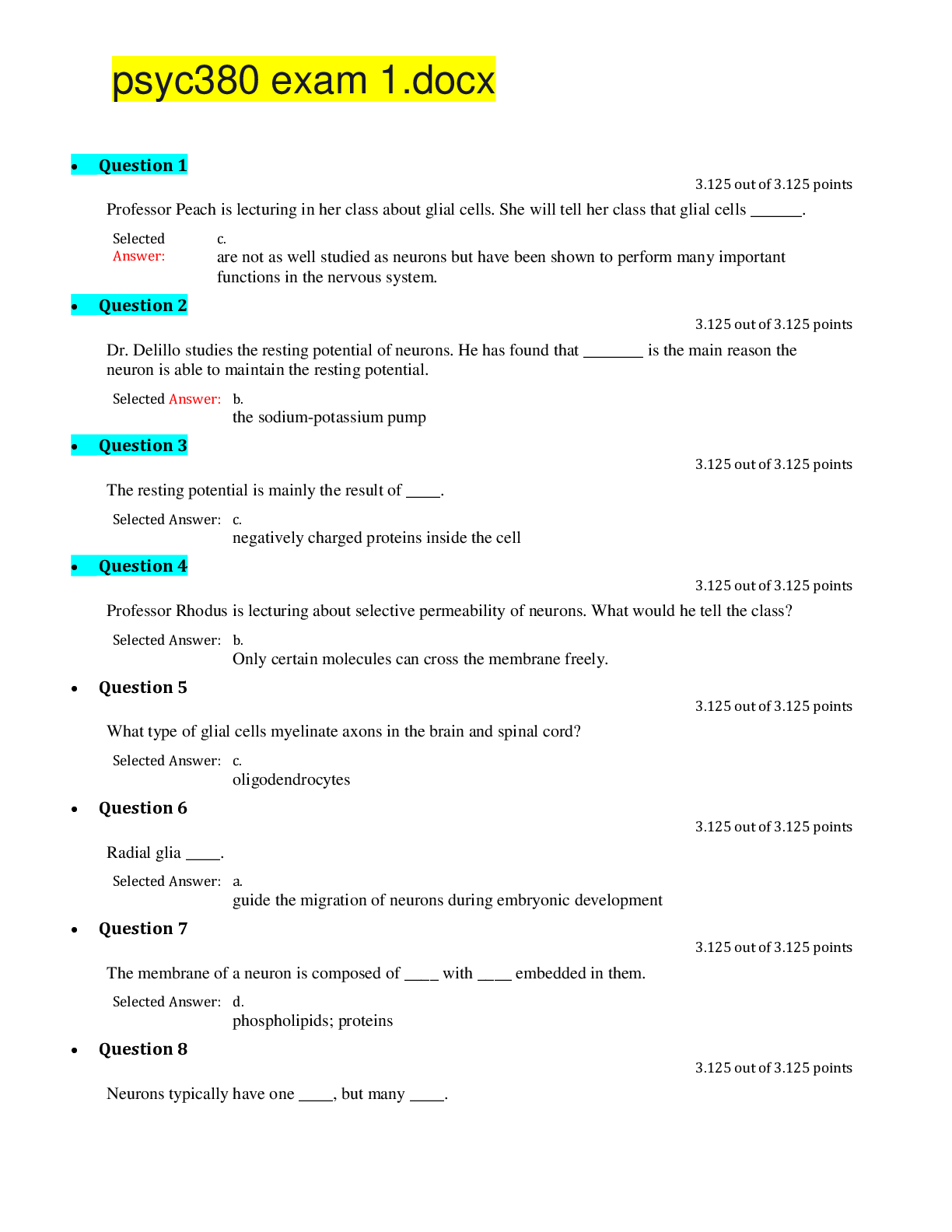
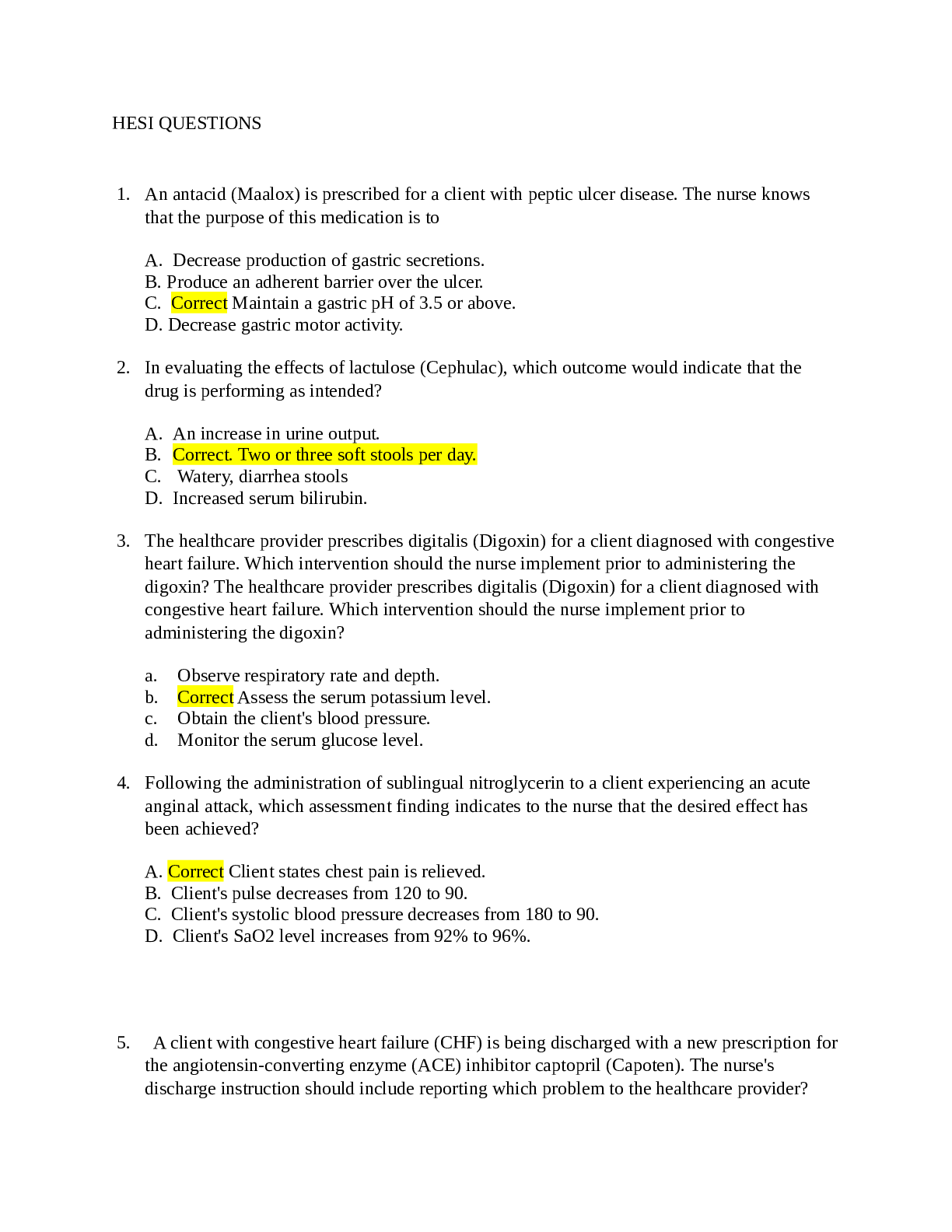



.png)









.png)
.png)
.png)
.png)
.png)
.png)
.png)

